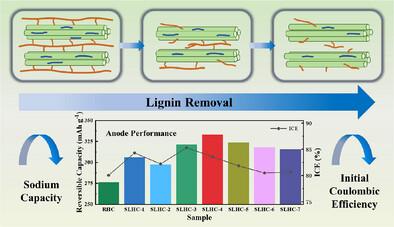生物质组分的精确解耦设计硬碳微晶结构以增强钠离子存储性能
IF 12.1
2区 材料科学
Q1 CHEMISTRY, MULTIDISCIPLINARY
引用次数: 0
摘要
钠离子电池用生物质硬碳(HC)阳极的广泛研究旨在通过精确操纵前驱体结构来优化钠的储存。现有的方法涉及刺激性酸或腐蚀性试剂,通常会增加生产成本,存在安全隐患,并造成不必要的碳损失,降低前驱体的利用效率。为了克服这些问题,本研究介绍了一种温和、环保、可扩展的方法,利用原料竹的选择性磺化。这种方法增强了木质素的亲水性,通过固液分离促进部分脱木质素。随后对富含纤维素的前驱体进行碳化,得到具有薄层伪石墨畴、层间间距扩大和致密闭孔结构的HC。所制备的阳极在30 mA g−1条件下的可逆容量为348 mAh g−1,初始库仑效率为84.2%,具有优异的倍率容量(900 mA g−1条件下为241 mAh g−1)和优异的循环稳定性(500 mA g−1条件下循环500次后容量保持率为97.8%)。非原位XRD和XPS分析进一步表明了吸附-插层/填充机制。这种可持续的预处理不仅提高了电化学性能,而且支持有效的木质磺酸回收,促进了木质纤维素生物质在储能应用中的综合和高价值利用。本文章由计算机程序翻译,如有差异,请以英文原文为准。

Precise Decoupling of Biomass Components to Engineer Hard Carbon Microcrystalline Architecture for Enhanced Sodium-Ion Storage Performance
Extensive research on biomass-derived hard carbon (HC) anodes for sodium-ion batteries has aimed to optimize sodium storage through precise manipulation of precursor structures. Existent methods, involving harsh acids or corrosive reagents, typically raise production costs, pose safety hazards, and cause unwanted carbon loss, reducing precursor utilization efficiency. To overcome these issues, this study introduces a mild, environmentally friendly, and scalable approach utilizing selective sulfonation of raw bamboo. This method enhances lignin hydrophilicity, facilitating partial delignification via solid-liquid separation. Subsequent carbonization of the cellulose-enriched precursor yields HC with thin-layered pseudo-graphitic domains, enlarged interlayer spacing, and dense closed-pore structures. The resulting anodes achieve a reversible capacity of 348 mAh g−1 at 30 mA g−1 with an initial Coulombic efficiency of 84.2%, excellent rate capability (241 mAh g−1 at 900 mA g−1), and superior cycling stability (97.8% capacity retention after 500 cycles at 500 mA g−1). Ex situ XRD and XPS analyses further indicate an adsorption-intercalation/filling mechanism. This sustainable pretreatment not only enhances electrochemical performance but also supports efficient lignosulfonate recovery, promoting comprehensive and high-value utilization of lignocellulosic biomass in energy storage applications.
求助全文
通过发布文献求助,成功后即可免费获取论文全文。
去求助
来源期刊

Small
工程技术-材料科学:综合
CiteScore
17.70
自引率
3.80%
发文量
1830
审稿时长
2.1 months
期刊介绍:
Small serves as an exceptional platform for both experimental and theoretical studies in fundamental and applied interdisciplinary research at the nano- and microscale. The journal offers a compelling mix of peer-reviewed Research Articles, Reviews, Perspectives, and Comments.
With a remarkable 2022 Journal Impact Factor of 13.3 (Journal Citation Reports from Clarivate Analytics, 2023), Small remains among the top multidisciplinary journals, covering a wide range of topics at the interface of materials science, chemistry, physics, engineering, medicine, and biology.
Small's readership includes biochemists, biologists, biomedical scientists, chemists, engineers, information technologists, materials scientists, physicists, and theoreticians alike.
 求助内容:
求助内容: 应助结果提醒方式:
应助结果提醒方式:


